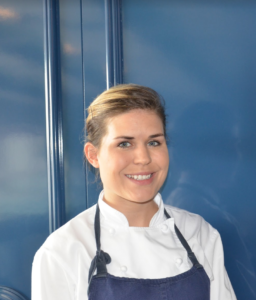
What made you want to Stage at Jane in San Francisco?
Jane is a small bakery with two store front locations. Although the bakery appears small when you enter, Jane has a very large wholesale operation with many small coffee shops and restaurants throughout the city. They recently opened a brand new off site bakery to increase the production capacity. I was initially drawn to Jane because of their viennoiserie program. Jorgen Carlsen is the head baker and I have admired his work through social media and had several people in the San Francisco area tell me that it was in fact just as amazing in person as it was in photos.
I had very little experience in viennoiserie other than puff pastry at Per Se so I really wanted to take the opportunity to understand the production of laminated dough at the quality Jane was achieving at the production level they were executing. Not only does Jane have an extraordinary lamination program – they also have some of the best sourdough bread in the area. I chose to go to Jane to really push myself outside of my comfort zone. I had only ever worked in a restaurant and not a bakery. Lastly, I chose San Francisco because of the produce that is available. I wanted to explore the farmers markets and visit the local restaurants to see how different the East and West coasts are agriculturally.
Can you describe what you did during your Stage?
Jane has three different shifts that each chef rotates through if they are working in the bakery. One person primarily laminates all of the viennoiseries, another person mixes and scales all of the bread and doughs for the day, and the last person is in charge of baking off all of the products. Throughout the day there are a lot of team projects as well. Every morning we start by making sure we "pack out" the wholesale items; we want to make sure all of the coffee shops are getting the freshest product bright and early everyday. As a team we also divide and shape all of the doughs at the end of the afternoon.
My first station and the primary station I worked at Jane was the scaling and mixing of all the bread doughs. This really sounded much easier to me than it actually is. Everyday I would mix 4 different types of dough that then turned into over 20 different products from baguettes to kouign amann. After and during mixing I was also scaling all of the dry ingredients for the next day's production. In between these tasks I would help shape croissants and also prepare ingredients for the bread (chop figs, mill speciality flours, make pastry cream, etc.). Once I was comfortable with that station I then shadowed the person in charge of lamination. This was less hands on and more of a learning and understanding of the meticulous systems and patience required to make laminated doughs. Lastly, I learned how to load the loader, score the bread, bake the bread, and unload the bread from the deck oven. It was particularly rewarding to pull out a beautifully scored and shaped baguette from the oven.
What stands out as some of the lessons that you learned during your experience?
I learned many things during this experience, from pre-shaping bread to the importance of hydration percentages in bread, with many other things in between. I learned that handling each dough is very different and the way you handle it can greatly affect the outcome of your final product. The weather, which is beyond your control, can drastically change your product and your schedule for a day. There are so many technical things that I learned working at Jane. The production schedule is probably the most important thing that I learned while I was at Jane, particularly in comparison to a restaurant's production schedule. When you are working at a restaurant you are constantly preparing for service. For a bakery there is no service. There is a very particular timeline that you are following and that timeline is set by the doughs you are working with. When the dough is ready it is important that you take action, whatever that may be – shape it, retard it, bake it. From a person that is able to set my schedule dependent on the tasks and availability of tools and resources for the day, it was very interesting to learn to work on a schedule based on the product I was working with.
Throughout this experience I achieved a much greater understanding of the art of bread baking. While bread is only composed of 4 major ingredients (flour, water, salt, and yeast), the end product can be very complex and varied. My newest position as the pastry chef at Apis Restaurant in Austin, Texas has recently proven that I needed the foundation of these skills to have a successful bread program. The sourdough that we make at Apis has transformed tremendously just by changing a few simple things that I learned at Jane. I have implemented an autolyse to improve the extensibility of our bread, I have increased the hydration level of the bread slightly to allow a more open crumb, I have changed the way I shape the bread to decrease the amount of “degassing” in the dough during this process, and I have increased the amount of initial steam to allow a crunchy and shiny crust. While I may have eventually discovered some of the solutions, there is no way that I would have discovered them so quickly and really have a greater understanding of how and why I needed to evaluate the bread the way I did and the drastic improvements it made.